November 10, 2016 at 3:42 pm
[caption id="attachment_2051" align="alignright" width="525"]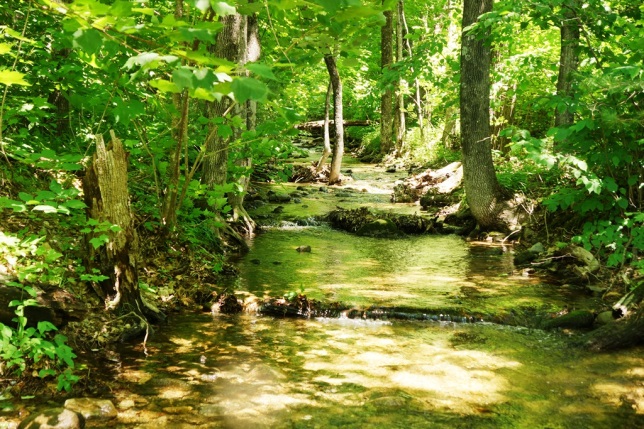 Cat Alley Brook, upstream of the clogged culvert.[/caption]
By IFW Fisheries Biologist Bob Van Riper
On an early July morning, I worked fast to move 26 brook trout upstream and out of the way. I had placed a blocking net upstream of where we intended to work, so that they would not venture downstream. As traffic whizzed by on Route 26 in Newry, I sat on the old culvert 75 feet downstream to wait for the contractor to arrive so we could get to work. As I waited, I recalled the events that had transpired to get our partners to the point of finally being able to get this part of the project completed…
In late summer 2014, fisheries biologists in the Rangley Lakes Region were approached by the Androscoggin Watershed Council about an old blocked culvert that, in addition to blocking fish movements, had clogged with debris and caused a small unnamed stream to cut a new channel. They requested that we evaluate the brook to determine its value as a fishery and to provide technical assistance in potentially removing it.
[caption id="attachment_2047" align="alignleft" width="507"]
Cat Alley Brook, upstream of the clogged culvert.[/caption]
By IFW Fisheries Biologist Bob Van Riper
On an early July morning, I worked fast to move 26 brook trout upstream and out of the way. I had placed a blocking net upstream of where we intended to work, so that they would not venture downstream. As traffic whizzed by on Route 26 in Newry, I sat on the old culvert 75 feet downstream to wait for the contractor to arrive so we could get to work. As I waited, I recalled the events that had transpired to get our partners to the point of finally being able to get this part of the project completed…
In late summer 2014, fisheries biologists in the Rangley Lakes Region were approached by the Androscoggin Watershed Council about an old blocked culvert that, in addition to blocking fish movements, had clogged with debris and caused a small unnamed stream to cut a new channel. They requested that we evaluate the brook to determine its value as a fishery and to provide technical assistance in potentially removing it.
[caption id="attachment_2047" align="alignleft" width="507"]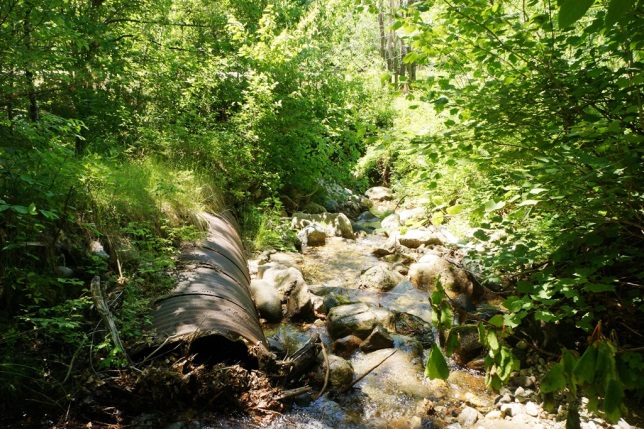 Cat Alley Brook – The offending culvert. State Route 26 can be seen above center. The downstream box culvert is the ‘dark spot’ below the roadway at left.[/caption]
The brook in question was a tributary to the Bear River, which flows from the Grafton Notch area. The Bear holds a wild population of brook trout, but it is a fickle stream; it is shallow overall, and it tends to warm up in the summer months – stressful conditions for trout. In order to survive, trout will search out areas of cool water to make it through the stressful summer.
[caption id="attachment_2050" align="alignright" width="444"]
Cat Alley Brook – The offending culvert. State Route 26 can be seen above center. The downstream box culvert is the ‘dark spot’ below the roadway at left.[/caption]
The brook in question was a tributary to the Bear River, which flows from the Grafton Notch area. The Bear holds a wild population of brook trout, but it is a fickle stream; it is shallow overall, and it tends to warm up in the summer months – stressful conditions for trout. In order to survive, trout will search out areas of cool water to make it through the stressful summer.
[caption id="attachment_2050" align="alignright" width="444"]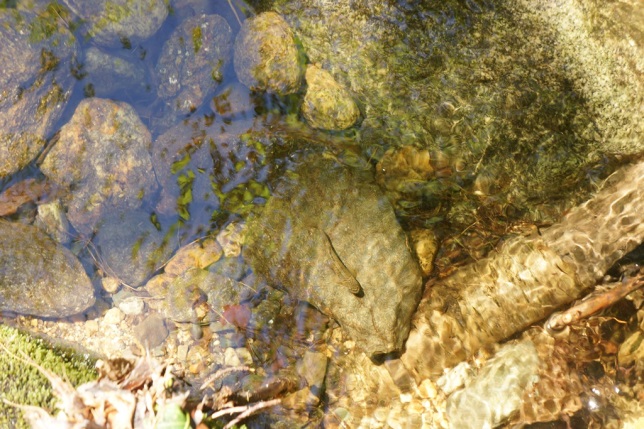 Cat Alley Brook. Two brook trout, the bigger of the two a bit harder to see (look above center)[/caption]
That fall, we met on site with the Watershed Council and MaineDOT. As we looked the site over, the story of the crossings were pieced together. The culvert upstream was where the old road was. When the current route was built, the old pipe was left in place, likely due to a request from a former landowner. When the culvert became clogged with debris, the stream channel bypassed the pipe and flowed towards the upstream wing wall of MaineDOT’s crossing. That part of the crossing was in need of repair because the channel was beginning to erode soils from behind it. MaineDOT indicated that the downstream side of the structure was also a maintenance issue and it planned to replace the Route 26 structure in the near future. However, they had no rights to remove the old culvert upstream, since they no longer owned it.
At the end of the first meeting, the partners agreed that MaineDOT would put together a timetable for replacing the Route 26 structure. The Watershed council was to secure funding, make municipal and landowner contacts, and hire a contractor to remove the old upstream culvert. MDIFW would evaluate the stream, make regulatory contacts, secure the necessary permits, and provide technical assistance. We also gave our stream a name, Cat Alley Brook, since just up the road a bit was a woods road named Cat Alley.
[caption id="attachment_2048" align="alignright" width="409"]
Cat Alley Brook. Two brook trout, the bigger of the two a bit harder to see (look above center)[/caption]
That fall, we met on site with the Watershed Council and MaineDOT. As we looked the site over, the story of the crossings were pieced together. The culvert upstream was where the old road was. When the current route was built, the old pipe was left in place, likely due to a request from a former landowner. When the culvert became clogged with debris, the stream channel bypassed the pipe and flowed towards the upstream wing wall of MaineDOT’s crossing. That part of the crossing was in need of repair because the channel was beginning to erode soils from behind it. MaineDOT indicated that the downstream side of the structure was also a maintenance issue and it planned to replace the Route 26 structure in the near future. However, they had no rights to remove the old culvert upstream, since they no longer owned it.
At the end of the first meeting, the partners agreed that MaineDOT would put together a timetable for replacing the Route 26 structure. The Watershed council was to secure funding, make municipal and landowner contacts, and hire a contractor to remove the old upstream culvert. MDIFW would evaluate the stream, make regulatory contacts, secure the necessary permits, and provide technical assistance. We also gave our stream a name, Cat Alley Brook, since just up the road a bit was a woods road named Cat Alley.
[caption id="attachment_2048" align="alignright" width="409"]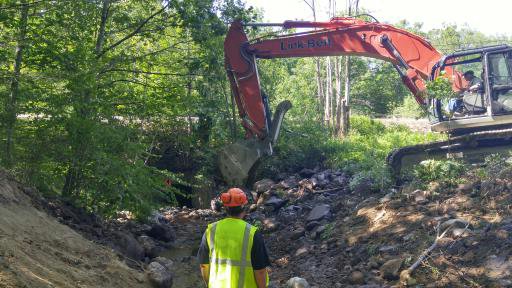 Cat Alley Brook. The old culvert is removed, the machine is reshaping the old channel, placing boulders, and grading the site where the culvert was removed. The start of bank stabilization can be seen at left.[/caption]
Fast forward to the summer of 2015. I went out with my backpack electrofishing unit and other stream survey tools to conduct the evaluation. I had expected to find trout, but did not know how many I would find. In the 65 foot long reach of stream between the two crossings, I sampled more than 30 brook trout! As I worked downstream, I found 30 more in the pool below the box culvert and a few more in pools downstream towards the Bear River. At least three age classes of wild trout were utilizing the brook; and that, coupled with the cold and well-oxygenated water, suggested that this was indeed a high value brook trout stream.
By the fall of 2015, most of the prep work had been completed. I had made the necessary contacts with state and federal agencies, had the permits all filled out, and had a plan to evacuate any resident fish and get the old culvert out. The Watershed Council had made all of the local contacts, secured funding through an Eastern Brook Trout Joint Venture grant and had gained permisson from the property owner to access the project and remove the old culvert.
Finally, during the summer of 2016, the big day had arrived. Caribou Springs, LLC had been selected to remove the pipe and do the stream rehabilitation work. Shortly after I had finished moving the fish out of the construction area, Jay Milot and son of Caribou Springs arrived, followed shortly by one big honkin’ shovel. We deployed temporary barriers to confine our work zone, set up an emergency barrier and moved the shovel on to the site.
A total of two hours later, the old culvert was crushed and strapped to a trailer, the stream channel was back in its former bed, numerous boulders had been scattered in the channel, the banks had been graded, seeded and stabilzed, and the water ran clear in its former home. We toasted our ‘success’ with bottles of cold water as we pulled the upstream block net and the trout scattered.
With the work done, the shovel was loaded and both it and the trailered pipe drove off, I looked the work over and thought to myself, “Two years effort to get here and it took us all of two hours to get this done”. It was all worth it.
We will continue working toward Phase Two of the project (the box culvert under Route 26) with MaineDOT. Once completed, all of Cat Alley Brook will be reconnected with the larger Bear River watershed and will once again allow fish to move freely throughout this important wild brook trout system.
[caption id="attachment_2049" align="aligncenter" width="1024"]
Cat Alley Brook. The old culvert is removed, the machine is reshaping the old channel, placing boulders, and grading the site where the culvert was removed. The start of bank stabilization can be seen at left.[/caption]
Fast forward to the summer of 2015. I went out with my backpack electrofishing unit and other stream survey tools to conduct the evaluation. I had expected to find trout, but did not know how many I would find. In the 65 foot long reach of stream between the two crossings, I sampled more than 30 brook trout! As I worked downstream, I found 30 more in the pool below the box culvert and a few more in pools downstream towards the Bear River. At least three age classes of wild trout were utilizing the brook; and that, coupled with the cold and well-oxygenated water, suggested that this was indeed a high value brook trout stream.
By the fall of 2015, most of the prep work had been completed. I had made the necessary contacts with state and federal agencies, had the permits all filled out, and had a plan to evacuate any resident fish and get the old culvert out. The Watershed Council had made all of the local contacts, secured funding through an Eastern Brook Trout Joint Venture grant and had gained permisson from the property owner to access the project and remove the old culvert.
Finally, during the summer of 2016, the big day had arrived. Caribou Springs, LLC had been selected to remove the pipe and do the stream rehabilitation work. Shortly after I had finished moving the fish out of the construction area, Jay Milot and son of Caribou Springs arrived, followed shortly by one big honkin’ shovel. We deployed temporary barriers to confine our work zone, set up an emergency barrier and moved the shovel on to the site.
A total of two hours later, the old culvert was crushed and strapped to a trailer, the stream channel was back in its former bed, numerous boulders had been scattered in the channel, the banks had been graded, seeded and stabilzed, and the water ran clear in its former home. We toasted our ‘success’ with bottles of cold water as we pulled the upstream block net and the trout scattered.
With the work done, the shovel was loaded and both it and the trailered pipe drove off, I looked the work over and thought to myself, “Two years effort to get here and it took us all of two hours to get this done”. It was all worth it.
We will continue working toward Phase Two of the project (the box culvert under Route 26) with MaineDOT. Once completed, all of Cat Alley Brook will be reconnected with the larger Bear River watershed and will once again allow fish to move freely throughout this important wild brook trout system.
[caption id="attachment_2049" align="aligncenter" width="1024"]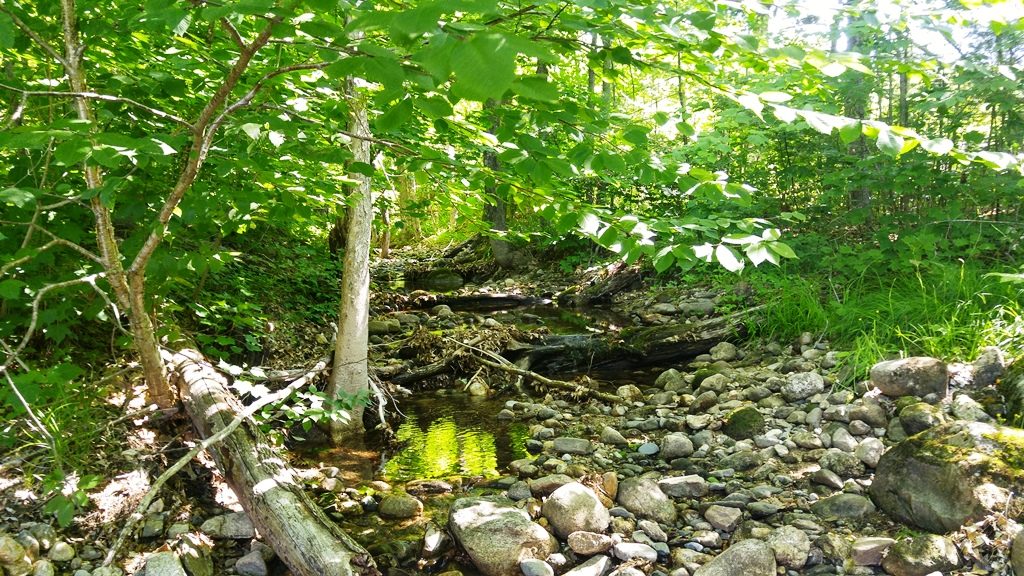 Cat Alley Brook. Site of the old culvert August 2016. The tree at center left is approximately where the clogged inlet of the culvert was.[/caption]
Cat Alley Brook. Site of the old culvert August 2016. The tree at center left is approximately where the clogged inlet of the culvert was.[/caption]
 Cat Alley Brook, upstream of the clogged culvert.[/caption]
By IFW Fisheries Biologist Bob Van Riper
On an early July morning, I worked fast to move 26 brook trout upstream and out of the way. I had placed a blocking net upstream of where we intended to work, so that they would not venture downstream. As traffic whizzed by on Route 26 in Newry, I sat on the old culvert 75 feet downstream to wait for the contractor to arrive so we could get to work. As I waited, I recalled the events that had transpired to get our partners to the point of finally being able to get this part of the project completed…
In late summer 2014, fisheries biologists in the Rangley Lakes Region were approached by the Androscoggin Watershed Council about an old blocked culvert that, in addition to blocking fish movements, had clogged with debris and caused a small unnamed stream to cut a new channel. They requested that we evaluate the brook to determine its value as a fishery and to provide technical assistance in potentially removing it.
[caption id="attachment_2047" align="alignleft" width="507"]
Cat Alley Brook, upstream of the clogged culvert.[/caption]
By IFW Fisheries Biologist Bob Van Riper
On an early July morning, I worked fast to move 26 brook trout upstream and out of the way. I had placed a blocking net upstream of where we intended to work, so that they would not venture downstream. As traffic whizzed by on Route 26 in Newry, I sat on the old culvert 75 feet downstream to wait for the contractor to arrive so we could get to work. As I waited, I recalled the events that had transpired to get our partners to the point of finally being able to get this part of the project completed…
In late summer 2014, fisheries biologists in the Rangley Lakes Region were approached by the Androscoggin Watershed Council about an old blocked culvert that, in addition to blocking fish movements, had clogged with debris and caused a small unnamed stream to cut a new channel. They requested that we evaluate the brook to determine its value as a fishery and to provide technical assistance in potentially removing it.
[caption id="attachment_2047" align="alignleft" width="507"] Cat Alley Brook – The offending culvert. State Route 26 can be seen above center. The downstream box culvert is the ‘dark spot’ below the roadway at left.[/caption]
The brook in question was a tributary to the Bear River, which flows from the Grafton Notch area. The Bear holds a wild population of brook trout, but it is a fickle stream; it is shallow overall, and it tends to warm up in the summer months – stressful conditions for trout. In order to survive, trout will search out areas of cool water to make it through the stressful summer.
[caption id="attachment_2050" align="alignright" width="444"]
Cat Alley Brook – The offending culvert. State Route 26 can be seen above center. The downstream box culvert is the ‘dark spot’ below the roadway at left.[/caption]
The brook in question was a tributary to the Bear River, which flows from the Grafton Notch area. The Bear holds a wild population of brook trout, but it is a fickle stream; it is shallow overall, and it tends to warm up in the summer months – stressful conditions for trout. In order to survive, trout will search out areas of cool water to make it through the stressful summer.
[caption id="attachment_2050" align="alignright" width="444"] Cat Alley Brook. Two brook trout, the bigger of the two a bit harder to see (look above center)[/caption]
That fall, we met on site with the Watershed Council and MaineDOT. As we looked the site over, the story of the crossings were pieced together. The culvert upstream was where the old road was. When the current route was built, the old pipe was left in place, likely due to a request from a former landowner. When the culvert became clogged with debris, the stream channel bypassed the pipe and flowed towards the upstream wing wall of MaineDOT’s crossing. That part of the crossing was in need of repair because the channel was beginning to erode soils from behind it. MaineDOT indicated that the downstream side of the structure was also a maintenance issue and it planned to replace the Route 26 structure in the near future. However, they had no rights to remove the old culvert upstream, since they no longer owned it.
At the end of the first meeting, the partners agreed that MaineDOT would put together a timetable for replacing the Route 26 structure. The Watershed council was to secure funding, make municipal and landowner contacts, and hire a contractor to remove the old upstream culvert. MDIFW would evaluate the stream, make regulatory contacts, secure the necessary permits, and provide technical assistance. We also gave our stream a name, Cat Alley Brook, since just up the road a bit was a woods road named Cat Alley.
[caption id="attachment_2048" align="alignright" width="409"]
Cat Alley Brook. Two brook trout, the bigger of the two a bit harder to see (look above center)[/caption]
That fall, we met on site with the Watershed Council and MaineDOT. As we looked the site over, the story of the crossings were pieced together. The culvert upstream was where the old road was. When the current route was built, the old pipe was left in place, likely due to a request from a former landowner. When the culvert became clogged with debris, the stream channel bypassed the pipe and flowed towards the upstream wing wall of MaineDOT’s crossing. That part of the crossing was in need of repair because the channel was beginning to erode soils from behind it. MaineDOT indicated that the downstream side of the structure was also a maintenance issue and it planned to replace the Route 26 structure in the near future. However, they had no rights to remove the old culvert upstream, since they no longer owned it.
At the end of the first meeting, the partners agreed that MaineDOT would put together a timetable for replacing the Route 26 structure. The Watershed council was to secure funding, make municipal and landowner contacts, and hire a contractor to remove the old upstream culvert. MDIFW would evaluate the stream, make regulatory contacts, secure the necessary permits, and provide technical assistance. We also gave our stream a name, Cat Alley Brook, since just up the road a bit was a woods road named Cat Alley.
[caption id="attachment_2048" align="alignright" width="409"] Cat Alley Brook. The old culvert is removed, the machine is reshaping the old channel, placing boulders, and grading the site where the culvert was removed. The start of bank stabilization can be seen at left.[/caption]
Fast forward to the summer of 2015. I went out with my backpack electrofishing unit and other stream survey tools to conduct the evaluation. I had expected to find trout, but did not know how many I would find. In the 65 foot long reach of stream between the two crossings, I sampled more than 30 brook trout! As I worked downstream, I found 30 more in the pool below the box culvert and a few more in pools downstream towards the Bear River. At least three age classes of wild trout were utilizing the brook; and that, coupled with the cold and well-oxygenated water, suggested that this was indeed a high value brook trout stream.
By the fall of 2015, most of the prep work had been completed. I had made the necessary contacts with state and federal agencies, had the permits all filled out, and had a plan to evacuate any resident fish and get the old culvert out. The Watershed Council had made all of the local contacts, secured funding through an Eastern Brook Trout Joint Venture grant and had gained permisson from the property owner to access the project and remove the old culvert.
Finally, during the summer of 2016, the big day had arrived. Caribou Springs, LLC had been selected to remove the pipe and do the stream rehabilitation work. Shortly after I had finished moving the fish out of the construction area, Jay Milot and son of Caribou Springs arrived, followed shortly by one big honkin’ shovel. We deployed temporary barriers to confine our work zone, set up an emergency barrier and moved the shovel on to the site.
A total of two hours later, the old culvert was crushed and strapped to a trailer, the stream channel was back in its former bed, numerous boulders had been scattered in the channel, the banks had been graded, seeded and stabilzed, and the water ran clear in its former home. We toasted our ‘success’ with bottles of cold water as we pulled the upstream block net and the trout scattered.
With the work done, the shovel was loaded and both it and the trailered pipe drove off, I looked the work over and thought to myself, “Two years effort to get here and it took us all of two hours to get this done”. It was all worth it.
We will continue working toward Phase Two of the project (the box culvert under Route 26) with MaineDOT. Once completed, all of Cat Alley Brook will be reconnected with the larger Bear River watershed and will once again allow fish to move freely throughout this important wild brook trout system.
[caption id="attachment_2049" align="aligncenter" width="1024"]
Cat Alley Brook. The old culvert is removed, the machine is reshaping the old channel, placing boulders, and grading the site where the culvert was removed. The start of bank stabilization can be seen at left.[/caption]
Fast forward to the summer of 2015. I went out with my backpack electrofishing unit and other stream survey tools to conduct the evaluation. I had expected to find trout, but did not know how many I would find. In the 65 foot long reach of stream between the two crossings, I sampled more than 30 brook trout! As I worked downstream, I found 30 more in the pool below the box culvert and a few more in pools downstream towards the Bear River. At least three age classes of wild trout were utilizing the brook; and that, coupled with the cold and well-oxygenated water, suggested that this was indeed a high value brook trout stream.
By the fall of 2015, most of the prep work had been completed. I had made the necessary contacts with state and federal agencies, had the permits all filled out, and had a plan to evacuate any resident fish and get the old culvert out. The Watershed Council had made all of the local contacts, secured funding through an Eastern Brook Trout Joint Venture grant and had gained permisson from the property owner to access the project and remove the old culvert.
Finally, during the summer of 2016, the big day had arrived. Caribou Springs, LLC had been selected to remove the pipe and do the stream rehabilitation work. Shortly after I had finished moving the fish out of the construction area, Jay Milot and son of Caribou Springs arrived, followed shortly by one big honkin’ shovel. We deployed temporary barriers to confine our work zone, set up an emergency barrier and moved the shovel on to the site.
A total of two hours later, the old culvert was crushed and strapped to a trailer, the stream channel was back in its former bed, numerous boulders had been scattered in the channel, the banks had been graded, seeded and stabilzed, and the water ran clear in its former home. We toasted our ‘success’ with bottles of cold water as we pulled the upstream block net and the trout scattered.
With the work done, the shovel was loaded and both it and the trailered pipe drove off, I looked the work over and thought to myself, “Two years effort to get here and it took us all of two hours to get this done”. It was all worth it.
We will continue working toward Phase Two of the project (the box culvert under Route 26) with MaineDOT. Once completed, all of Cat Alley Brook will be reconnected with the larger Bear River watershed and will once again allow fish to move freely throughout this important wild brook trout system.
[caption id="attachment_2049" align="aligncenter" width="1024"] Cat Alley Brook. Site of the old culvert August 2016. The tree at center left is approximately where the clogged inlet of the culvert was.[/caption]
Cat Alley Brook. Site of the old culvert August 2016. The tree at center left is approximately where the clogged inlet of the culvert was.[/caption]